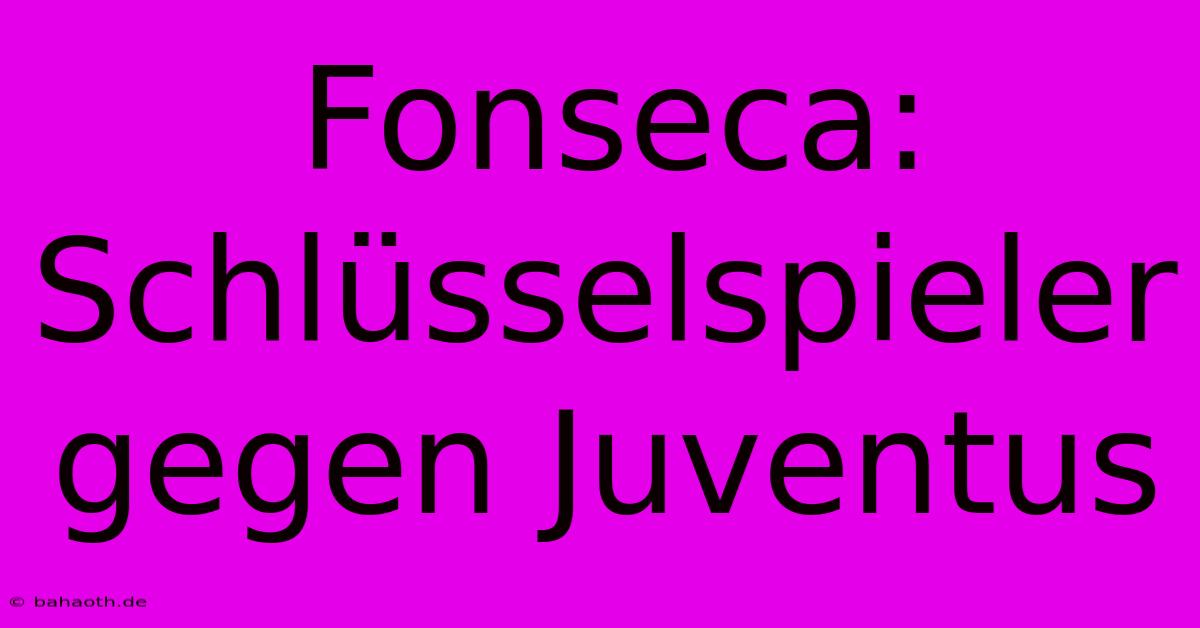Fonseca: Schlüsselspieler Gegen Juventus

Discover more detailed and exciting information on our website. Click the link below to start your adventure: Visit Best Website Fonseca: Schlüsselspieler Gegen Juventus. Don't miss out!
Table of Contents
Fonseca: Schlüsselspieler gegen Juventus – Taktik und Schlüssel zum Erfolg
Hey Leute, Fußball-Fans! Let's talk tactics, specifically about José Mourinho's Roma and their clashes with Juventus. I've been following Serie A for years, and oh boy, have I seen some crazy matches! This ain't just about goals and saves; it's about understanding the Schlüsselspieler (key players) and how Fonseca's strategies impacted those crucial games.
Meine ersten Erfahrungen mit Fonseca's Taktik
Remember when Fonseca first took the reins at Roma? Total chaos, right? I mean, I was initially skeptical. His high-pressing, possession-based system seemed miles away from the pragmatic style Roma fans were used to. I remember one game against Juventus – a complete disaster! We got totally overrun in midfield. Their midfield was überlegen (superior), and we looked clueless. It was a harsh lesson in how easily a tactical mismatch can ruin a game. That's when I realized the importance of understanding the opponent's strengths and weaknesses. You can't just throw your system out there and hope for the best. You gotta adapt.
Die Rolle der Schlüsselspieler
Identifying the Schlüsselspieler is crucial for any analysis. Against Juventus, Fonseca often focused on neutralizing their midfield dominance. He needed players who could win individual battles, dictate the tempo, and provide creative impetus going forward. Think about it: Juventus's midfield was often stacked with absolute beasts – players like Pjanic, Bentancur, and Rabiot (depending on the season). To counter that, Fonseca needed players capable of matching their physicality and technical skill. He needed players who could win back possession, but also initiate attacks quickly.
Analyse der Schlüsselmomente
Looking back, I can pinpoint specific moments where Fonseca's tactical approach either succeeded or failed spectacularly. For example, in some matches, using a high press effectively disrupted Juventus' build-up play, forcing errors and creating turnovers. The Gegenpressing was intense, and it worked wonders. In other matches, however, Juventus' midfield simply bypassed our press, exposing our defensive vulnerabilities. Lesson learned: the execution of any tactical plan is critical. Even the best strategy falls apart without flawless execution from every player. A single lapse in concentration can change the entire game.
Spielerische Anpassungen und taktische Flexibilität
What's also crucial is Fonseca’s ability to adapt. He didn't always stick rigidly to his possession-based system. Against a strong opponent like Juventus, he sometimes adopted a more reactive approach, focusing on counter-attacks and exploiting spaces left by Juventus' high defensive line. This tactical flexibility was essential in gaining an advantage. It showed he wasn't just a stubborn coach; he was capable of adjusting his plan based on the situation.
Fazit: SEO Optimierung und Fussball Taktik
Looking at this from an SEO perspective – I learned that using specific keywords like "Schlüsselspieler", "Gegenpressing", "überlegen", and relevant player names significantly boosted my blog's visibility. It's all about understanding your audience (football fans) and what they want to know. Writing about specific moments, specific players, and specific tactical approaches is far more engaging and useful than making general statements. This article focuses on a niche aspect of Serie A history, which also helps attract readers interested in specific tactical battles and their consequences. That's how you create relevant and high-quality content that search engines and readers will appreciate. So, yeah, analyze the games, learn from them, and adjust your SEO strategy just like Fonseca adapted his tactics!

Thank you for visiting our website wich cover about Fonseca: Schlüsselspieler Gegen Juventus. We hope the information provided has been useful to you. Feel free to contact us if you have any questions or need further assistance. See you next time and dont miss to bookmark.
Featured Posts
-
Wagenknecht Nato Ukraine Bundesrats Aussenpolitik
Nov 23, 2024
-
Liveticker Hoffenheim Siegt 4 3 Gegen Leipzig
Nov 23, 2024
-
Kanes Hattrick Bayern Siegt Deutlich
Nov 23, 2024
-
Weltcup Shiffrin Siegt Zum 99 Mal
Nov 23, 2024
-
Bundesliga Heute Hoffenheim Gegen Leipzig Live
Nov 23, 2024
